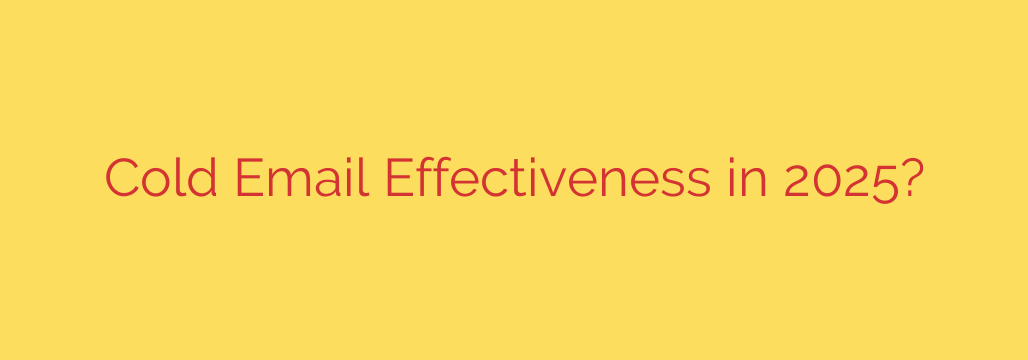
Is Cold Email Dead? A Look at Its Effectiveness in 2025
In the world of digital marketing and sales, the question comes up every year: is cold email finally dead? With inboxes more crowded than ever and spam filters growing smarter by the day, it’s a valid concern. The short answer is no, cold email is not dead. However, the game has changed dramatically.
The old “spray and pray” method of sending thousands of generic templates is officially obsolete. To succeed with cold outreach in 2025 and beyond, you need a smarter, more strategic, and fundamentally more human approach. Think of it less as cold outreach and more as starting a thoughtful conversation.
Here’s what you need to know to make your cold emails not only land in the inbox but also get a response.
The Shifting Landscape: Why Old Tactics Fail
If you’re still using a 2018 playbook, you’re likely seeing dismal results. Several factors have contributed to this shift:
- Inbox Saturation: Decision-makers are bombarded with hundreds of emails daily. Standing out requires more than a catchy subject line; it requires genuine relevance.
- Smarter AI-Powered Filters: Platforms like Google and Microsoft use sophisticated AI to detect mass-sent, impersonal emails and filter them out before they ever reach the primary inbox.
- Increased User Skepticism: People are more aware of phishing and spam than ever before. An email that looks even slightly generic or untrustworthy is deleted without a second thought.
Key Pillars of Successful Cold Email in 2025
To overcome these challenges, your strategy must be built on a modern foundation. Success now hinges on three core principles: personalization, technical integrity, and value.
1. Hyper-Personalization is Non-Negotiable
Simply using a [First Name] tag is no longer enough. True personalization means doing your homework. Before you even think about writing, you should have answers to these questions:
- What is this person’s role and responsibilities?
- Have they recently been promoted or changed jobs?
- Did their company just launch a product, publish a case study, or receive funding?
- Have they written an article or been quoted in one?
Your opening line should immediately signal that this is not a mass email. Reference a specific post they made on LinkedIn, a comment they shared in a webinar, or a recent company achievement.
Generic templates are the fastest way to the spam folder. Your goal is to create an email so tailored that it feels like it could only have been sent to one person.
2. Technical Deliverability and Sender Reputation are Crucial
You can write the world’s best email, but it’s worthless if it never reaches the inbox. Email service providers are cracking down on accounts with poor sending practices.
Your sender reputation is your most valuable asset in cold outreach. To protect it, you must have your technical house in order:
- Set Up Authentication Protocols: Ensure your domain has SPF, DKIM, and DMARC records properly configured. These are like digital signatures that prove to email providers that you are who you say you are, significantly reducing the chance of being marked as spam.
- Warm Up Your Email Account: If you’re using a new email account for outreach, don’t start by sending hundreds of emails on day one. Gradually increase your sending volume over several weeks to build a positive reputation.
- Maintain a Clean List: Regularly verify your email lists to remove invalid or outdated addresses. High bounce rates are a major red flag to email providers and will damage your sender reputation.
3. Shift from “Pitching” to “Providing Value”
An effective cold email is not about you, your company, or your product. It’s about the recipient and their problems. Your message must quickly answer their unspoken question: “What’s in it for me?”
Instead of leading with “I’m from X company and we sell Y,” try an approach centered on their potential needs. For example:
- “I saw your company is expanding into the European market. We helped [Similar Company] navigate the complexities of GDPR compliance during their expansion, which saved them significant time.”
Sending 10 highly researched, value-driven emails is far more effective than sending 1,000 generic ones. This quality-over-quantity mindset is the key to breaking through the noise.
Actionable Tips for a High-Performing Cold Email
- Craft a Compelling (but not Clickbait) Subject Line: Keep it short, personal, and intriguing. “Question about [Topic]” or “Idea for [Their Company Name]” often works better than a sales-focused subject.
- Make the First Sentence About Them: Your opening line is your most important real estate. Don’t waste it by introducing yourself. Start with your research and a personalized hook.
- Keep it Short and Scannable: No one wants to read a wall of text from a stranger. Use short sentences, break up paragraphs, and bold key phrases. Aim for a total length of 50-125 words.
- End with a Low-Friction Call-to-Action (CTA): Instead of asking for a 30-minute meeting, which is a high-commitment request, use a softer CTA. A simple, interest-based question like, “Is this a priority for you right now?” is often more effective at starting a conversation.
The Verdict
Cold email isn’t dead, but low-effort, mass-volume cold email is. The future of successful outreach lies in being more thoughtful, more targeted, and more human. By investing time in research, ensuring your technical setup is sound, and focusing on providing genuine value, you can turn a “cold” email into a warm conversation. The platforms and filters will only get smarter, so the best strategy is to create outreach that deserves to be in the primary inbox.
Source: https://collabnix.com/is-cold-email-still-effective-in-2025/








